History of Istanbul
The city today known as Istanbul has been the site of human settlement for approximately three thousand years. The settlement, whose earliest known name is Lygos,[1] was founded by Thracian tribes.[2] It was colonised by the Greeks in the 7th century BC. It fell to the Roman Republic in 196 BC,[3] and was known as Byzantium until 330, when it was renamed Constantinople and made the new capital of the Roman Empire. During late antiquity, the city rose to be the largest of the western world, with a population peaking at close to half a million people. Constantinople was the capital of the Byzantine Empire, which ended with the fall of Constantinople in 1453. Constantinople then became the capital of the Ottoman Empire.
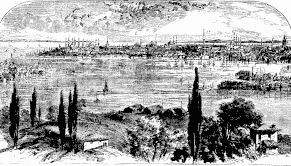
Population had declined during the medieval period, but as the Ottoman Empire approached its historical peak, the city grew to a population of close to 700,000 in the 16th century, once again ranking among the world's most populous cities. When the Republic of Turkey was founded in 1923, the capital was moved from Constantinople to Ankara (previously Angora). Since 1930, the native name "Istanbul" has been the sole official name of the city in Turkish and has since replaced the traditional name "Constantinople" in most western languages as well.
Prehistory
Humans have lived in the area now known as Istanbul since at least the Neolithic period. The earliest known settlement dates from 6700 BC, discovered in 2008, during the construction works of the Yenikapı subway station and the Marmaray tunnel at the historic peninsula on the European side.[4][5][6] The first human settlement on the Anatolian side, the Fikirtepe mound, is from the Copper Age period, with artifacts dating from 5500 to 3500 BC.[7] In nearby Kadıköy (Chalcedon) a port settlement dating back to the Phoenicians has been discovered.
Lygos
The first name of the city was Lygos[8] according to Pliny the Elder in his historical accounts. It was founded by Thracian tribes, along with the neighbouring fishing village of Semistra.[9] Only a few walls and substructures belonging to Lygos have survived to date, near the Seraglio Point (Turkish: Sarayburnu),[2] where the famous Topkapı Palace now stands. Lygos and Semistra were the only settlements on the European side of Istanbul. On the Asian side there was a Phoenician colony. On the site of Lygos, the later Byzantium was located, thus Lygos is accepted as the city which gave rise to Istanbul.
Byzantium
Byzantion (Βυζάντιον), Latinized as Byzantium, was the next name of the city. The name is believed to be of Thracian or Illyrian origin and thus to predate the Greek settlement.[2] It may be derived from a Thracian or Illyrian personal name, Byzas.[10]:352ff Ancient Greek legend refers to a legendary king Bizas as the leader of the Megarean colonists and eponymous founder of the city. Cape Moda in Chalcedon was the first location which the Greek settlers from Megara chose to colonize in 685 BC, prior to colonizing Byzantion on the European side of the Bosphorus under the command of King Byzas in 667 BC. Byzantion was established on the site of an ancient port settlement named Lygos[9] During the period of Byzantion, the Acropolis used to stand where the Topkapı Palace stands today.
After siding with Pescennius Niger against the victorious Septimius Severus the city was besieged by Rome and suffered extensive damage in AD 196.[3] Byzantium was rebuilt by the Roman Emperor Septimius Severus and quickly regained its previous prosperity, being temporarily renamed as Augusta Antonina by the emperor, in honor of his son.
Late Roman period and the Eastern Roman (Byzantine) Empire
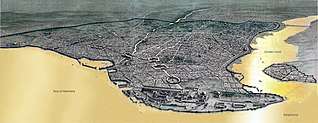
The location of Byzantium attracted Constantine the Great in 324 after a prophetic dream was said to have identified the location of the city; but the true reason behind this prophecy was probably Constantine's final victory over Licinius at the Battle of Chrysopolis (Üsküdar) on the Bosphorus, on 18 September 324, which ended the civil war between the Roman Co-Emperors, and brought an end to the final vestiges of the Tetrarchy system, during which Nicomedia (present-day İzmit, 100 km east of Istanbul) was the most senior Roman capital city. Byzantium (now renamed as Nova Roma which eventually became Constantinopolis, i.e. The City of Constantine) was officially proclaimed the new capital of the Roman Empire in 330. At the end of his reign in 337, Constantine declared his three sons as joint heirs of the Roman Empire in a system of co-emperorship.[11] However, the sons couldn't govern together peacefully and their military rivalry split the empire on the north–south line along the Balkan Peninsula. The territory was officially split in 395 when Theodosius I (ruled, 379-395) died, leaving his son Honorius emperor of the western half, and his other son Arcadius emperor of the eastern half of the empire.[11]
Constantinople became the capital of the Eastern Roman (Byzantine) Empire. The combination of imperial power and a key location at the crossing point between the continents of Europe and Asia, and later Africa and others regions, played an important role in terms of commerce, culture, diplomacy, and strategy. It was the center of the Greek world and, for most of the Byzantine period, the largest city in Europe. Constantine's conversion to Christianity, in 312, had set the Roman Empire towards Christianization, and in 381, during the reign of Theodosius I, the official state religion of the Roman Empire became Christianity, turning Constantinople into a thriving religious center.[12]
Throughout the fifth century, the western half of the Roman Empire lost most of its power through decline in political, economic and social situations, the last western emperor being deposed by Germanic mercenaries in AD 476; the eastern half, however, was flourishing. According to historians this flourishing Eastern Roman Empire was then classified as the Byzantine Empire to distinguish it from the Roman Empire.[13] This empire was distinctly Greek in culture, and became the centre of Greek Orthodox Christianity after an earlier split with Rome, and was adorned with many magnificent churches, including Hagia Sophia, once the world's largest cathedral. The seat of the Patriarch of Constantinople, spiritual leader of the Eastern Orthodox Church, remains.
The most famous Byzantine emperor was Justinian (527-565). During his reign he extended the Byzantine Empire to its largest boundaries spreading from Palestine to the tip of Spain. His other achievements include the famous Hagia Sophia church and the organized law system called the Codex which was completed in 534.[14] However, Justinian's reign was the greatest influence of the Byzantine Empire.
Starting in the 600's, warfare kept Constantinople's power flip-flopping between decline and progression. Alliance with Europe slowly began to break away from the Byzantine Empire between the seventh-eighth centuries, when the Byzantine and Roman churches disagreed on various subjects. However, the distinguishing gap placed between the two churches involved the use of icons in the church. Icons, being images of Christian holy people such as Jesus Christ, the Virgin Mary and the saints, to Byzantine Christians were more than representations; they were believed to possess holy power that affected people's daily lives[15] While many Byzantines worshiped icons many opposed the icons because they tested the authorities of the emperor. Finally in 726, Emperor Leo III (ruled, 717-741) ordered all icons to be destroyed. The destruction of icons reorganized and reoriented the Byzantine rulers in imperial power.[16] The fierce opposition to icons clashed with the pope's tolerance of images. The papacy was unwilling to permit sacred images and icons to be destroyed and this caused eventual separation.[17] Their separation caused hatred between the two churches and cooperation between the two was a struggle.
From around the 9th to 13th centuries, Constantinople developed complex relationships with an emerging and later the largest and most advanced state of that time in Europe - Kiev Rus. Constantinople played a significant role in the Kiev Rus development, culture, and politics. Many of the Kiev Princes were married to daughters of the Byzantine Emperors, and because of this connection Eastern Europe became Orthodox, after it was Christianized by Vladimir the Great of Kiev. However these relationships were not always friendly - Constantinople was sacked several times over those 400 years by Kiev Princes, forcing Constantinople to sign increasingly favorable treaties for Kiev, the texts of which were preserved in the Primary Chronicle and other historical documents (see Rus'-Byzantine Wars). Byzantine constantly played Kiev, Poland, Bulgaria, and other European Nations of that time, against each other.
Near 1204, Constantinople began to decline in power. Because of the failure of the Third Crusade, self-confident western Europeans decided to again try to capture the Holy City of Jerusalem in the Fourth Crusade; but this time their plan was to capture the Byzantine Empire as well. In 1204, western armies captured Constantinople and ransacked the city for treasures.[18] The pope decried the sacking of Constantinople but ordered the crusaders to consolidate their gains in the city for a year. The crusaders chose Baldwin of Flanders to be the new Byzantine Emperor; he along with other princes and the Venetians divided the Empire amongst themselves; they never made it to Jerusalem.[18] This new Latin Empire at Constantinople lasted until 1261, when the Byzantines under the command of Michael VIII Palaeologus recaptured the city and some outlying territory.[18] After this, Constantinople never regained its former glory. Rather than a thriving metropolis, Constantinople transformed into a collection of villages, and became a semi-ghost town with, as Ibn Battuta noted, sown fields within the city walls. The city by 1453 held less than a tenth of its former population.
Ottoman Empire
The city, known alternatively in Ottoman Turkish as Ḳosṭanṭīnīye (قسطنطينيه after the Arabic form al-Qusṭanṭīniyyah القسطنطينية) or Istanbul (while its Christian minorities continued to name it Constantinople, as did people writing in French, English, and other western languages), was the capital of the Ottoman Empire from its conquest in 1453 until the empire's collapse in 1922.
There are two theories as to where the name Istanbul is derived from, one being "εις την Πόλη" Greek for "to The City" pronounced "is-tin-poli". Alternatively the renaming of Constantinople to Istanbul may have been derived from "Stanbul" the Russian & Turk (foreigner-shortened) words of (Κωνσταντινούπολη) pronounced "Constantinoupoli".
Also, the Turks could not properly pronounce words beginning with two constants and beginning with "s" without adding an "i" in front. Thus for the Turks Stanbul became Istanbul, similarly Izmir for Smyrne (Σμύρνη) etc.
Conquest
.jpg)
On 29 May 1453, Sultan Mehmed II "the Conqueror", entered Constantinople after a 53–day siege during which his cannon had torn a huge hole in the Walls of Theodosius II. The city became the third capital of the Ottoman Empire.
Mehmed had begun the siege on 6 April 1453. He had hired engineers to build cannons and bombs for the occasion. He also acquired scholars and imams to encourage the soldiers. In accordance with Shariah (Muslim Holy Law), Mehmed gave the Byzantine emperor Constantine Palaeologus (1449–1453) three chances to surrender the city.[19] He guaranteed the safety of the city's residents, with their riches, beliefs and honor. Constantine valiantly refused the offer.[20] After more than a month of fighting, Mehmed's advisors were beginning to lose hope. Against their counsel, Mehmed continued to fight. The night before the final assault, he studied previous attempts to take the city to distinguish potentially successful approaches. On the morning of 29 May 1453 the sultan ordered Adzan (the call to prayer).[21] This was not a regular prayer session for religious reasons but rather a scare tactic: the sight of the entire Ottoman army getting on their knees to pray provided an intimidating display of unity to the Byzantine forces designed to overcome their minds before their bodies.[21]
Once the fighting started, it went on for forty-eight days. The wall was beginning to collapse when Constantine sent a letter to the pope asking for help. In response the Papacy sent five ships full of reinforcements, weapons and supplies. Another defense tactic involved Constantine blocking off the port so that the Ottoman army could not get ships into it. Mehmed had his people pave a path from oiled tree branches in order to bring eighty ships overland, and placed them into the gulf behind the enemy ships. The Ottoman ships burnt the Byzantine ones in a naval battle.[22]
Since the Byzantine army was still holding on after this defeat, the sultan thought it was time to set up his secret weapon, a huge mobile tower. This tower could hold many soldiers who could be at the same level as the walls of the city, making it easier for them to break into Constantinople. The first group of Ottomans who entered the city were killed almost immediately, with the effect that the other Muslims began to retreat. Witnessing this, the sultan encouraged his soldiers. Soon after the sultan's encouragement the Muslims broke the wall in two places and entered the city. In a last attempt to protect it, Constantine attacked the enemy sword raised; however he was defeated and killed.[23]
Finally, Constantinople was under Ottoman rule. Mehmed entered Constantinople through what is now known as the Topkapi Gate. He immediately rode his horse to the Hagia Sophia which he ordered to be sacked. He ordered that an imam meet him there in order to chant the Muslim Creed: "I testify that there is no God but Allah. I testify that Muhammad is the Prophet of Allah."[24] He turned the Orthodox cathedral into a Turkish mosque, solidifying Turkish rule in Constantinople. Mehmed ordered the city to be plundered for three days; during this time, widespread persecution of the city's civilian inhabitants took place, resulting in thousands of casualties, rapes and forced deportations.[25] Following the sack, Mehmed's main concern with Constantinople had to do with rebuilding the city's defenses and re-population. Building projects were commenced immediately after the conquest, which included the repair of the walls, construction of the citadel, and building a new palace.[19] Mehmed issued orders across his empire that Muslims, Christians, and Jews should resettle the city; he demanded that five thousand households needed to be deported to Constantinople by September.[26]
Imperial capital
By 1459, the Sultan dedicated a lot of energy to bringing prosperity to Constantinople. In several quarters of the city pious foundations were created; these areas consisted of a theological college, a school (or a Madrasa, usually connected to the mosque[27]), a public kitchen, and a mosque.[19] In the same year Mehmed sent out orders that any Greeks who had left Constantinople as slaves or refugees should be allowed to return. These actions led it to become a once again thriving capital city, now of the Ottoman Empire.[19]
Suleiman the Magnificent's reign over the Ottoman Empire from 1520 to 1566 was a period of great artistic and architectural achievements. The famous architect Mimar Sinan designed many mosques and other grand buildings in the city, while Ottoman arts of ceramics and calligraphy also flourished. Many tekkes survive to this day; some in the form of mosques while others have become museums such as the Cerrahi Tekke and the Sünbül Efendi and Ramazan Efendi mosques and türbes in Fatih, the Galata Mevlevihanesi in Beyoğlu, the Yahya Efendi tekke in Beşiktaş, and the Bektaşi Tekke in Kadıköy, which now serves Alevi Muslims as a cemevi.
In the final years of the Byzantine Empire, the population of Constantinople had fallen steadily, throwing the great imperial city into the shadow of its past glory. For Mehmet II, conquest was only the first stage; the second was giving the old city an entirely new cosmopolitan social structure. Most of what remained of the Byzantine population - a mere 30,000 persons - was deported. According to the Ashikpashazade, a Turkish chronicle,
Mehmet then sent officers to all his lands to announce that whoever wished should come and take possession in Constantinople, as freehold, of houses and orchards and gardens ... Despite this measure the city was not repopulated. So then the Sultan commanded that from every land families, rich and poor alike, should be brought in by force ... and now the city began to be populous.[29]
Mehmet took much personal interest in the creation of his new capital. On his orders the great mosque and the college of Fatih were built on the old burial grounds of the Byzantine Emperors at the Church of the Holy Apostles. Bit by bit the great Christian city was transformed into a great Muslim city. Even so, the city was not to be entirely Muslim, at least not until the late 20th century. Slavs, Greeks, Jews and Armenians, all of whose diverse skills were needed, were allowed to settle in a city which was to become known as alem penah-refuge of the universe. According to the census of 1477, there were 9,486 houses occupied by Muslims; 3,743 by Greeks; 1,647 by Jews; 267 by Christians from the Crimea, and 31 Gypsies. Mehmet also re-established Constantinople, as it was still called at that time, as the center of the Orthodox patriarchate.
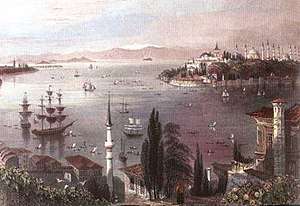
There was also an Italian community in the area of the Galata Tower. Having surrendered before the fall of the city, Mehmet allowed them to preserve an element of self-government. For generations after, they supplied interpreters and diplomats for the Ottoman Court. After the conquest of Egypt in 1517, and the Sultan's acceptance of the position of Caliph, Constantinople acquired an additional importance in Muslim eyes. Mosques built by Suleyman the Magnificent and his successors gave the city the unique appearance it still preserves today. The individual communities, though, still lived in self-contained areas, and had little in the way of social interaction, a source of future trouble.
Until the eighteenth century, living standards were at least equal to most of Europe. For example, the development of urban craftsmen's wages was on a level similar to southern and central Europe during the sixteenth to eighteenth century.[30]
Foundations
"Foundations" is vakifs in Turkish. The Grand Bazaar (1455) and Topkapı Palace (1459) were erected in the years following the Turkish conquest. Religious foundations were endowed to fund the building of mosques such as the Fatih (1463) and their associated schools and public baths. The city had to be repopulated by a mixture of force and encouragement.
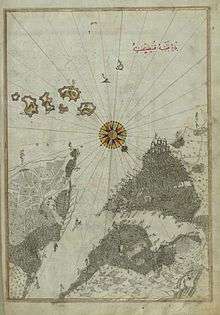
Süleyman's reign was a time of great artistic and architectural achievements. The architect Sinan designed many mosques and other great buildings in the city, while Ottoman arts of ceramics and calligraphy also flourished.
Sufi orders which were so widespread in the Islamic world and who had many followers who had actively participated in the conquest of the city came to settle in the capital. During Ottoman times over 100 Tekkes were active in the city alone. Many of these Tekkes survive to this day some in the form of mosques while others as museums such as the Jerrahi Tekke in Fatih, the Sunbul Effendi and Ramazan Effendi Mosque and Turbes also in Fatih, the Galata Mevlevihane in Beyoğlu, the Yahya Effendi Tekke in Beşiktaş, and the Bektashi Tekke in Kadıköy, which now serves Alevi Muslims as a Cem Evi.
Modernisation
As the years passed the population increased, from about 80,000 at the death of Mehmet, to 300,000 by the 18th century, and 400,000 in 1800. The capital of an empire that stretched across Europe, Asia and Africa, it also became an important diplomatic centre, with several foreign embassies. It was only after 1922, following the war between Greece and Turkey that things really began to change.
The city was modernized from the 1870s onwards with the building of bridges, the creation of a proper water system, the use of electric lights, and the introduction of trams and telephones.
 Stamboul (the old walled city), around 1896
Stamboul (the old walled city), around 1896 A street in Eyüp in 1890s
A street in Eyüp in 1890s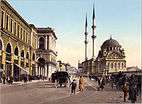 Tophane in 1890s
Tophane in 1890s
Republic of Turkey
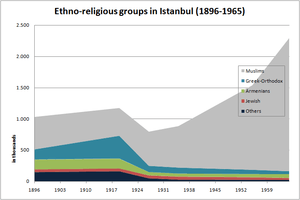
After the First World War, the Armistice of Mudros decreed that Constantinople would be occupied by Allied Forces. On 13 November 1918, the Occupation of Constantinople by Allied forces began, ending on 4 October 1923.[31]
When the Republic of Turkey was founded under Mustafa Kemal Atatürk on 29 October 1923, the capital was moved from Constantinople to Angora, which became Ankara in English. As a consequence, population collapsed, from an estimated 1,125,000 in 1914 to about 500,000 in 1924; but population steadily grew during the later 20th century, the metropolitan population surpassing 10 million in the year 2000.
The city's current name İstanbul is a shortened version with a Turkish character of the Medieval Greek phrase "εἰς τὴν Πόλιν" [is tin ˈpolin], meaning "into the city", which had long been in vernacular use by the local population. The international name Constantinople also remained in use until Turkey adapted the Latin alphabet in 1928 and urged other countries to use the city's Turkish name in their languages and their postal service networks. In 1929 Lloyd's agents were informed that telegrams now must be addressed to "Istanbul" or "Stamboul", but The Times stated that mail could still be delivered to "Constantinople".[32] However The New York Times stated that year that mail to "Constantinople" may no longer be delivered.[33] In 1929 Turkish Nationalists advocated for the usage of Istanbul in English instead of Constantinople.[34] The U.S. State Department began using "Istanbul" in May 1930.[35]
With the establishment of the new Turkish Republic, built on a wave of nationalism, there was a mass exodus of much of the Greek and Armenian population from Istanbul, which had ceased to be the capital. After riots in 1955 the remaining fraction also departed.
In the early years of the republic, Istanbul was overlooked in favour of Ankara, the new capital. However, starting from the late 1940s and early 1950s, Istanbul underwent great structural change, as new public squares (such as Taksim Square), boulevards and avenues were constructed throughout the city; sometimes at the expense of the demolition of many historical buildings.
In September 1955, many ethnic Greek businesses were destroyed during the Istanbul pogrom. This accelerated the departure of Greeks from the city and from Turkey. Jews, Armenians, and Georgians were also targeted.
Starting from the 1970s, the population of Istanbul began to rapidly increase, as people from Anatolia migrated to the city in order to find employment in the many new factories that were constructed at the outskirts of the sprawling metropolis. This sudden sharp rise in the city's population caused a large demand for housing development, and many previously outlying villages and forests became engulfed into the greater metropolitan area of Istanbul.
In 2013, Taksim Square was the center of the Gezi Park protests, where protesters protested a wide range of concerns at the core of which were issues of freedom of the press, of expression, assembly, and the government's encroachment on Turkey's secularism.
See also
References
- Pliny the Elder, book IV, chapter XI: Archived 1 January 2017 at the Wayback Machine
- Janin, Raymond (1964). Constantinople byzantine. Paris: Institut Français d'Études Byzantines. p. 10f.
- A New Classical Dictionary of Greek and Roman Biography, Mythology and Geography. 1860. p. 1003.
- BBC: "Istanbul's ancient past unearthed" Published on 10 January 2007. Retrieved on 3 March 2010.
- Hürriyet: Bu keşif tarihi değiştirir (2 October 2008)
- Hürriyet: Photos from the Neolithic site, circa 6500 BC
- "Cultural Details of Istanbul". Republic of Turkey, Minister of Culture and Tourism. Retrieved 2 October 2007.
- Pliny the Elder, book IV, chapter XI:
"On leaving the Dardanelles we come to the Bay of Casthenes, ... and the promontory of the Golden Horn, on which is the town of Byzantium, a free state, formerly called Lygos; it is 711 miles from Durazzo, ..." Archived 1 January 2017 at the Wayback Machine - Vailhé, S. (1908). "Constantinople". Catholic Encyclopedia. 4. New York: Robert Appleton Company. Retrieved 12 September 2007.
- Georgacas, Demetrius John (1947). "The Names of Constantinople". Transactions and Proceedings of the American Philological Association. The Johns Hopkins University Press. 78: 347–67. doi:10.2307/283503. JSTOR 283503.
- Hunt, Lynn. The Making of the West, Peoples and Cultures. 2nd ed. A, To 1500. Mary Dougherty and Denise B. Wydra. Boston: Bedford/St. Martin's, 2005. p. 248
- Hunt, Lynn. The Making of the West, Peoples and Cultures. 2nd ed. A, To 1500. Mary Dougherty and Denise B. Wydra. Boston: Bedford/St. Martin's, 2005. p. 253
- Hunt, Lynn. The Making of the West, Peoples and Cultures. 2nd ed. A, To 1500. Mary Dougherty and Denise B. Wydra. Boston: Bedford/St. Martin's, 2005. p. 272
- Hunt, Lynn. The Making of the West, Peoples and Cultures. 2nd ed. A, To 1500. Mary Dougherty and Denise B. Wydra. Boston: Bedford/St. Martin's, 2005. pp. 273–276
- Hunt, Lynn. The Making of the West, Peoples and Cultures. 2nd ed. A, To 1500. Mary Dougherty and Denise B. Wydra. Boston: Bedford/St. Martin's, 2005. p. 291
- Hunt, Lynn. The Making of the West, Peoples and Cultures. 2nd ed. A, To 1500. Mary Dougherty and Denise B. Wydra. Boston: Bedford/St. Martin's, 2005. p. 292
- Hunt, Lynn. The Making of the West, Peoples and Cultures. 2nd ed. A, To 1500. Mary Dougherty and Denise B. Wydra. Boston: Bedford/St. Martin's, 2005. pp. 313–314
- Hunt, Lynn. The Making of the West, Peoples and Cultures. 2nd ed. A, To 1500. Mary Dougherty and Denise B. Wydra. Boston: Bedford/St. Martin's, 2005. p. 427
- Inalcik, Halil. "The Policy of Mehmed II toward the Greek Population of Istanbul and the Byzantine Buildings of the City." Dumbarton Oaks Papers 23, (1969): 229-249
- Hatzopoulos, Dionysios. "The Fall of Constantinople." http://www.greece.org/Romiosini/fall.html (accessed 2012-05-31). p. 6
- Eversley, Lord. The Turkish Empire from 1288 to 1914. 3rd ed. Howard Fertig. New York: Howard Fertig Inc., 1924. p. 2
- Hatzopoulos, Dionysios. "The Fall of Constantinople." http://www.greece.org/Romiosini/fall.html (accessed 2/10/08). p. 7
- Hatzopoulos, Dionysios. "The Fall of Constantinople." http://www.greece.org/Romiosini/fall.html (accessed 2/10/08). pp. 4–10
- Lewis, Bernard. Istanbul and the Civilization if the Ottoman Empire. 1, University of Oklahoma Press, 1963. p. 6
- Mansel, Philip (1995). Constantinople: City of the World's Desire. Hachette UK. p. 79. ISBN 0-7195-5076-9.
- Inalcik, Halil. "The Policy of Mehmed II toward the Greek Population of Istanbul and the Byzantine Buildings of the City." Dumbarton Oaks Papers 23, (1969): 229-249. p. 236
- Hunt, Lynn. The Making of the West, Peoples and Cultures. 2nd ed. A, To 1500. Mary Dougherty and Denise B. Wydra. Boston: Bedford/St. Martin's, 2005. p. 330
- Byzantium 1200: Monastery of Saint George of the Mangana
- Mansel, Philip (July 2003). "Europe's Muslim Capital". History Today. 53 (6).
- Baten, Jörg (2016). A History of the Global Economy. From 1500 to the Present. Cambridge University Press. p. 212. ISBN 9781107507180.
- Stephen Pope; Elizabeth-Anne Wheal (1995). "Select Chronology". Dictionary of the First World War. Macmillan. ISBN 978-0-85052-979-1.
- "Telegraphic Name For Constantinople". The Times (45369). 25 November 1929. p. 12.
- "Topics of the Times: The Passing of Constantinople". New York Times. 15 November 1929. p. 19.
- ""ISTANBUL": The Correct Way of Writing Constantinople". The Manchester Guardian. 15 November 1929. p. 11., also mentioned in "MISCELLANY: The Name-Changers". The Manchester Guardian. 16 November 1929. p. 11.
- "Washington Accepts "Istanbul" As Replacing "Constantinople"". The New York Times. 28 May 1930. Retrieved 1 April 2020.
Further reading
- Boyar, Ebru; Fleet, Kate. A Social History of Ottoman Istanbul (Cambridge University Press, 2010. 376 pp.) online review
- Derviş, Pelin, Bülent Tanju, and Uğur Tanyeli, eds. Becoming Istanbul: An Encyclopedia (Istanbul: Ofset Yapımevi, 2008)
- Freely, John. Istanbul: The Imperial City (Penguin, 1998). Popular history
- Göktürk, Deniz, Levent Soysal, and İpek Türeli, eds. Orienting Istanbul: Cultural Capital of Europe? (Routledge, 2010)
- Hofmann, Anna; Öncü, Ayşe (eds.): "History takes Place - Istanbul, Dynamics of Urban Change", JOVIS Verlag Berlin 2015, ISBN 978-3-86859-368-6
- Inalcik, Halil; Quataert, Donald. An Economic and Social History of the Ottoman Empire, 1300-1914.
- Kafadar, Cemal. Between Two Worlds: the Construction of the Ottoman State.
- Kafescioğlu, Çiğdem. Constantinopolis/Istanbul: Cultural Encounter, Imperial Vision, and the Construction of the Ottoman Capital (Pennsylvania State University Press, 2009) 295 pp. online review
- Keyder, Çağlar ed. Istanbul between the global and the local (Rowman & Littlefied Publishers, 1999).
- Mansel, Philip. Istanbul: City of the World's Desire, 1453-1924 (London: John Murray, 1995); Popular history
- Mills, Amy Streets of Memory: Landscape, Tolerance, and National Identity in Istanbul (University of Georgia Press, 2010) 248 pp. online review
- Zürchner, E. J.. Turkey a Modern History

